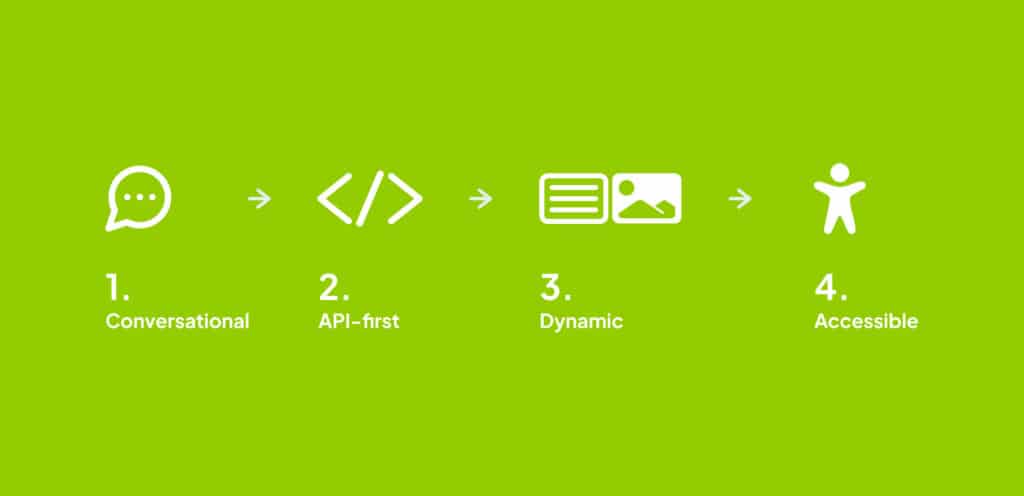Hand on heart: how often in the past few months have you used a classic navigation bar instead of simply typing a question into a chat interface? That tiny shift in behaviour is the seed of what analysts are calling the Agentic trend. Deloitte expects that by 2025 one quarter of all companies already working with generative AI will be running pilot projects that rely on autonomous agents; the firm projects that share to double again by 2027. These agents do far more than exchange polite small talk. They reserve flights, configure lease contracts, juggle calendar entries and trigger approvals without ever touching a single pixel of a traditional website. At the same time, SEO pioneer Jono Alderson warns that brand reputation will soon be tracked not in the visible web but in what he calls the latent memory of large language models. That is the moment my internal alarm bell rings: any enterprise that still optimizes solely for mouse-over menus and touch gestures could find itself stranded in a semantic no-man’s-land tomorrow. Yet demonizing chatbots as natural enemies of the site would be a category mistake. What is really happening is a relocation of the battleground. Visibility is becoming memorability; to put it bluntly, traffic is turning into a token in the semantic space. In other words, our content must survive in dialog form without forcing us to tear down the underlying web framework. The mission is to teach our digital assets to speak fluently in conversations while continuing to anchor them firmly in the open web.
Agentic AI in a Nutshell
Agentic AI is the next evolutionary step for the assistants we still steer politely with prompts today. Its core can be nailed down in three concepts: autonomy, goal orientation and context awareness. Autonomy means a system no longer waits for every single instruction but plans, prioritizes and executes tasks independently. Goal orientation means the agent chases measurable outcomes like revenue targets, service-level agreements or compliance thresholds rather than answering each request in isolation. Finally, context awareness enables the agent to weave data streams from CRM, ERP or PIM platforms into a living knowledge graph so that its decisions adapt on the fly. IBM highlights the distinction from classic generative AI: where a language model mainly creates text, an Agentic system performs actions such as triggering a purchase order or sending a contract without anyone babysitting each intermediate step. Industry blogs have therefore started calling the phenomenon an autonomous digital worker, a software colleague that manages processes the way a junior project manager would. For web strategists the implication is clear: from now on we write not only for humans, search engines and conversational bots but also for decision algorithms that will treat our content as a springboard for real-world actions. Enterprises that link their data cleanly, define sharp objectives and open robust APIs invite these agents to become part of their value chain. Those that cling to silos will offer only half a story and be bypassed by their algorithmic co-workers.
Informational Websites Under Pressure: When Answers Are Everywhere
Let’s be brutally honest: the world no longer needs a fourteen-page marketing microsite just to deliver a handful of facts. Why would anyone study a traditional FAQ when a chatbot can serve up the perfect bite-sized answer in seconds, complete with a how-to video? The uncomfortable truth is that pure information sites are under intense pressure. Before anyone reaches for the off switch, however, it is worth peeking behind the curtain. Large language models live and die by the training data they ingest. If you lock your institutional knowledge behind logins or bury it inside PDFs, the models cannot consume it; at best you show up in their answers as a footnote, if at all. Structured data, semantic markup and clean HTML are therefore no longer SEO nice-to-haves. They have become acts of content self-preservation. In many verticals Google remains the gatekeeper for chatbots because the open web index is still the primary nutrition for most models. Neglect your domain today and you surrender not merely rankings but the very basis of machine memory. The takeaway is not abolition but concentration: information pages must become more specialized, deeper and above all legible to models. Pristine code, accurate Schema.org vocabulary and openly licensed snippets that machines can quote are the new prerequisites for staying relevant in a dialog-driven landscape.
Complex Platforms and the SEO Foundation: The Operational Heart Keeps Beating
Things look very different once real money changes hands. In late 2023 TIME Magazine recorded a Swift-induced traffic spike of one hundred thousand requests per second with zero timeouts, all running on WordPress VIP. During the solar eclipse NASA delivered twenty-two million page views within hours without breaking a sweat. These are not workloads a lone chatbot can shoulder. Enterprise storefronts process intricate pricing rules, talk via API to ERP systems, obey tax zones and respect data-sovereignty boundaries. That is where the operational heart of a website continues to beat: as an integration hub, an audit layer and a legally safe transaction zone. WordPress has long since evolved from blogging tool to scalable application layer. Headless configurations deliver content through GraphQL to apps, voice interfaces and yes, chatbots themselves. SEO remains the anchor: page speed, Core Web Vitals, entities and backlinks still signal relevance to machines. The difference is that we used to chase the blue link on page one, whereas today we must sculpt the prompt engine inside models so that our brand is surfaced as a credible source. Robust, fast, well-structured endpoints are non-negotiable if we want to keep that seat at the table.

Integration Accessibility and Next Steps: Rethinking Websites
So the core question is not whether websites will disappear but how we will reassemble them for the decade ahead. I see four work streams.
First is the conversational layer.
A chat widget at checkout does not replace the cart but shortens the decision path when it can pull product sheets, inventory levels and discount rules straight from the CMS and in many cases turbo-charges conversion.
Second is the API-first economy.
CRM, PIM and library systems must deliver data as JSON, not as pretty brochures.
Third is dynamic content.
Season, location and browsing history can all enrich a landing page on the fly as long as privacy and consent modes are honored.
Fourth is accessibility.
Anything a screen reader cannot decode will be unreliable fodder for a language model. Alt attributes, logical headings and ARIA labels therefore serve double duty: indispensable for both humans and machines.
For large enterprises that means budgets will shift away from cosmetic relaunches toward durable data governance. Headless CMS platforms, GraphQL gateways and semantic pipelines may sound technical, yet they are basically corporate self-insurance. Command the distribution logic of your content today and you force tomorrow’s agents to knock politely rather than breeze past with indifference.
Conclusion: Corporate Websites Are Far from Finished
At the end of this brief expedition I remain convinced that chatbots will transform many things, yet complex websites are still the engine room where revenue, compliance and brand experience are orchestrated. For a global WordPress agency like Syde that spells not farewell but forward march. We are not standing at the end of the website era but at the threshold of its next evolutionary stage: fewer pixels, more protocol. Anyone who understands that reality will enlist Agentic AI as an ally and turn the corporate domain into an indispensable node in tomorrow’s conversation network.
Ready to future-proof your digital presence?

Related articles
-

Rethinking WordPress Multisite: Simpler, Smarter, More User-Friendly
When WordPress 3.0 was released back in 2010, named Thelonious after jazz pianist Thelonious Monk, it introduced a feature that fascinated me immediately: Multisite.
-

Contributing to Something Bigger: My Hacktoberfest Experience at Syde
Hacktoberfest has become a recurring highlight in my year and a moment that reminds me why I am committed to open source and why I enjoy being part of Syde.
